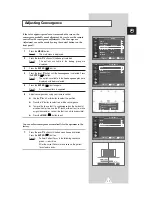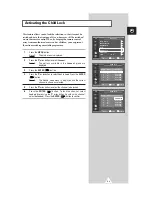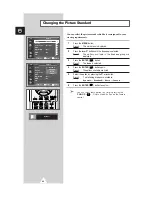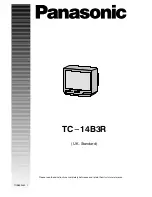
11
ENG
Switching Your Television On and Off
TV
The mains lead is attached to the rear of your television.
1
Plug the mains lead into an appropriate socket.
➢
The main voltage is indicated on the rear of the television
and the frequency is 50 or 60Hz.
2
Press the “
I
” button (On/Off) on the front of the television.
Result:
The Standby indicator on the front of the television
lights up.
3
Press the
POWER
(
) button on the remote control to switch the
television on.
Result:
The programme that you were watching last is re-
selected automatically.
➣
◆
If your television isn’t turned on when the
POWER
(
)
button is pressed, press the
SELECT
button to check if
the “
TV
” mode has been chosen
.
◆
If you have not yet stored any channels, No clear picture
appears. Refer to “Storing Channels Automatically” on
page 18 or “Storing Channels Manually” on page 20.
4
To switch your television off, press the “
I
” button (On/Off) again.
Placing Your Television in Standby Mode
Your television can be placed in Standby mode, in order to reduce
the power consumption.
The Standby mode can be useful when you wish to interrupt
viewing temporarily (during a meal, for example).
1
Press the
POWER
(
) button on the remote control.
Result:
The screen is turned off and the Standby indicator on
the front of the television lights up.
2
To switch the television back on, simply press the
POWER
(
)
button again or a numeric button.
➣
You can also switch on by pressing the
TV
(
) or channel
up/ down (
P
/
) button.
☛
Do not leave your television in Standby mode for long
periods of time (when you are away on holiday, for
example). Turn your television off by pressing the “
I
”
button (On/Off) on the front of the television. It is best to
unplug the set from the mains and aerial.
TV












































